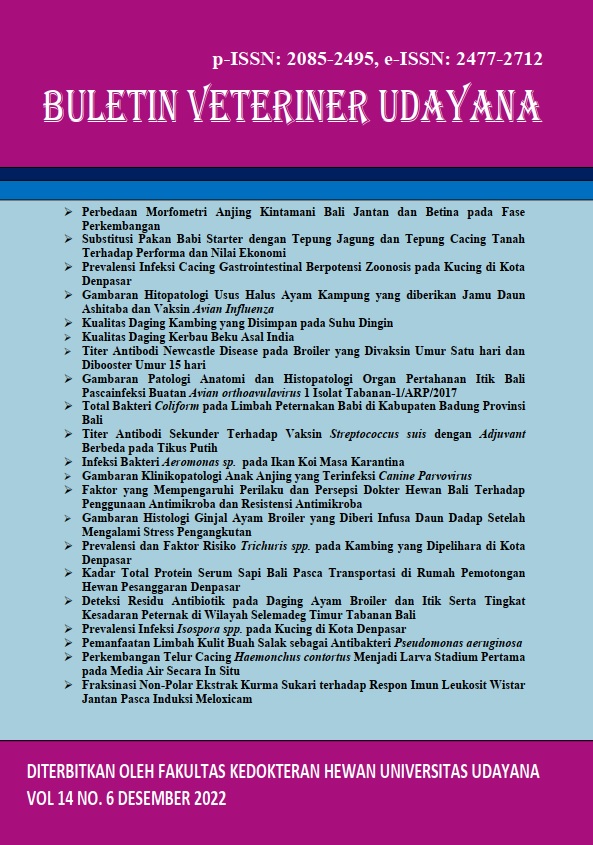PREVALENCE OF ISOSPORA SPP. INFECTION IN CATS IN DENPASAR CITY
Abstract
Cats are one of the most popular pets in the world with a wide variety of breeds, and as pets that get attention to be kept and bred.The common gastrointestinal protozoa that infect cats are Gardia felis, Cryptosporidium felis, Isospora felis, Isospora rivolta, Toxoplasma gondii, Hammondia hammondi and Sarcocystis sp., while Pentatrichomonas hominis can infect the large intestine. This study aims to determine the prevalence of infection and the relationship between some factors (breed, sex, age, and maintenance management) on gastrointestinal protozoa in cats in Denpasar. This study involved 100 samples of cat feces and the data were analyzed by chi-square. Samples were examined using the floating concentration method, with a saturated NaCl flotation agent. The results showed that the prevalence of gastrointestinal protozoa infections in cats reached 24% (24/100). Breed, sex, age and maintenance management factors were not associated with the prevalence of gastrointestinal protozoa infections in cats.
Downloads
References
Barutzki D, Schaper R. 2003. Endoparasites in dogs and cats in Germany 1990-2002. Veterinary Laboratory Freiburg, Freiburg, Germany.
Bowman DD, Barr SC, Hendrix CM, Lindsay DS. 2003. Gastro-intestinal parasites of cat. International Veterinary Information Services, Ithaca, New York, USA.
Hildreth AM, Vantassel SM, Hygnstrom SE. 2010. Feral cats and their management. University of Nebraska Lincoln.
Lorenzini G, Tasca, Carli GAD. 2007. Prevalence of intestinal parasites in dogs and cats under veterinary care in Porto Alegre, Rio Grande Do Sul, Brazil. Braz. J. Vet. Res. Anim. Sci. 44(2): 137-145.
Lukiswanto BS, Yuniarti WM. 2013. Pemeriksaan fisik pada anjing dan kucing. Airlangga University Press.
Milliana M. 2010. Prevalence of stray cats with intestinal protozoan parasites. Am. J. Anim. Vet. Sci. 5(3): 86-90.
Mohsen A, Hossein H. 2009. Gastrointestinal parasites of stray cats in Kashan, Iran. J. Trop. Biomed. 26(1): 16-22.
Nofisulastri N. (2018). Studi karakter morfologi kucing peranakan anggora hasil perkawinan silang alami. J. Ilmiah Biol. 6(2): 114-119.
Pagati AL, Suwanti LT, Anwar C, Yuniarti WM, Sarmanu, Suprihati E. 2018. Prevalance of gastrointestinal protozoa of cats in animal hospital and animal clinic in Surabaya. J. Parasite Sci. 2(2): 61-66.
Raji AA, Magaji AA, Bello MB, Lawal MD, Mamuda A, Yahaya MS. 2013. Prevalence of gastrointestinal parasites of stray cats: a case study of two hospitals in Sokoto Metropolis, Sokoto, Nigeria. J. Bacteriol. Parasitol. 4(4): 1-4.
Robbie MH, Fajeria AL, Pratiwi L, Aeka A. 2020. Gastrointestinal protozoa helminthiasis and coccidiosis infection in domestic cat. Vet. Med. J. 2020: 97-110.
Setyoningsih AP. 2004. Identifikasi protozoa saluran pencernaan kucing dari beberapa lokasi di Bali. Fakultas Kedokteran Hewan Universitas Udayana Denpasar.
Subekti DT, Arrasyida NK. 2006. Toxoplasma gondii imunopathogenesis based on different strains. Wartazoa. 16(3): 128-145.
Subrata IM, Oka IBM, Agustina KK. 2017. Prevalence of intestinal worm in free ranging domestic cats in Bali. J. Vet. 18(3): 441-445.
Sucitrayani PTE, Oka IBM, Dwinata IM. 2014. Prevalensi infeksi protozoa saluran pencernaan pada kucing lokal (felis catus) di Denpasar. Bul. Vet. Udayana. 6(2): 153-159.
Tuzio H, Edwards D, Elston T, Jarboe L, Kudrak S, Richards J, Rodan I. 2004. Feline zoonoses guidelines from the American Association of Feline Practitioners. J. Feline Med. Surg. 7: 243-274 .





